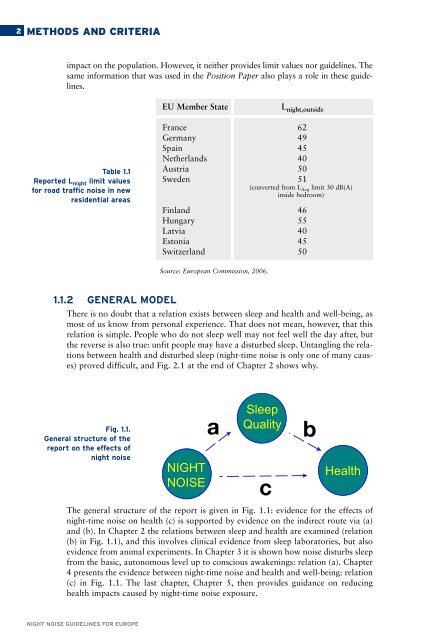Night noise guidelines for Europe - WHO/Europe - World Health ...
Night noise guidelines for Europe - WHO/Europe - World Health ...
Night noise guidelines for Europe - WHO/Europe - World Health ...
Create successful ePaper yourself
Turn your PDF publications into a flip-book with our unique Google optimized e-Paper software.
2<br />
METHODS AND CRITERIA<br />
impact on the population. However, it neither provides limit values nor <strong>guidelines</strong>. The<br />
same in<strong>for</strong>mation that was used in the Position Paper also plays a role in these <strong>guidelines</strong>.<br />
EU Member State<br />
L night,outside<br />
Table 1.1<br />
Reported L night limit values<br />
<strong>for</strong> road traffic <strong>noise</strong> in new<br />
residential areas<br />
France 62<br />
Germany 49<br />
Spain 45<br />
Netherlands 40<br />
Austria 50<br />
Sweden 51<br />
(converted from L Aeq limit 30 dB(A)<br />
inside bedroom)<br />
Finland 46<br />
Hungary 55<br />
Latvia 40<br />
Estonia 45<br />
Switzerland 50<br />
Source: <strong>Europe</strong>an Commission, 2006.<br />
1.1.2 GENERAL MODEL<br />
There is no doubt that a relation exists between sleep and health and well-being, as<br />
most of us know from personal experience. That does not mean, however, that this<br />
relation is simple. People who do not sleep well may not feel well the day after, but<br />
the reverse is also true: unfit people may have a disturbed sleep. Untangling the relations<br />
between health and disturbed sleep (night-time <strong>noise</strong> is only one of many causes)<br />
proved difficult, and Fig. 2.1 at the end of Chapter 2 shows why.<br />
Fig. 1.1.<br />
General structure of the<br />
report on the effects of<br />
night <strong>noise</strong><br />
NIGHT<br />
NOISE<br />
a<br />
Sleep<br />
Quality<br />
<strong>Health</strong><br />
The general structure of the report is given in Fig. 1.1: evidence <strong>for</strong> the effects of<br />
night-time <strong>noise</strong> on health (c) is supported by evidence on the indirect route via (a)<br />
and (b). In Chapter 2 the relations between sleep and health are examined (relation<br />
(b) in Fig. 1.1), and this involves clinical evidence from sleep laboratories, but also<br />
evidence from animal experiments. In Chapter 3 it is shown how <strong>noise</strong> disturbs sleep<br />
from the basic, autonomous level up to conscious awakenings: relation (a). Chapter<br />
4 presents the evidence between night-time <strong>noise</strong> and health and well-being: relation<br />
(c) in Fig. 1.1. The last chapter, Chapter 5, then provides guidance on reducing<br />
health impacts caused by night-time <strong>noise</strong> exposure.<br />
c<br />
b<br />
NIGHT NOISE GUIDELINES FOR EUROPE

















